YAMAHA BANSHEE 350 2011 Owners Manual
Manufacturer: YAMAHA, Model Year: 2011, Model line: BANSHEE 350, Model: YAMAHA BANSHEE 350 2011Pages: 148, PDF Size: 4.53 MB
Page 131 of 148
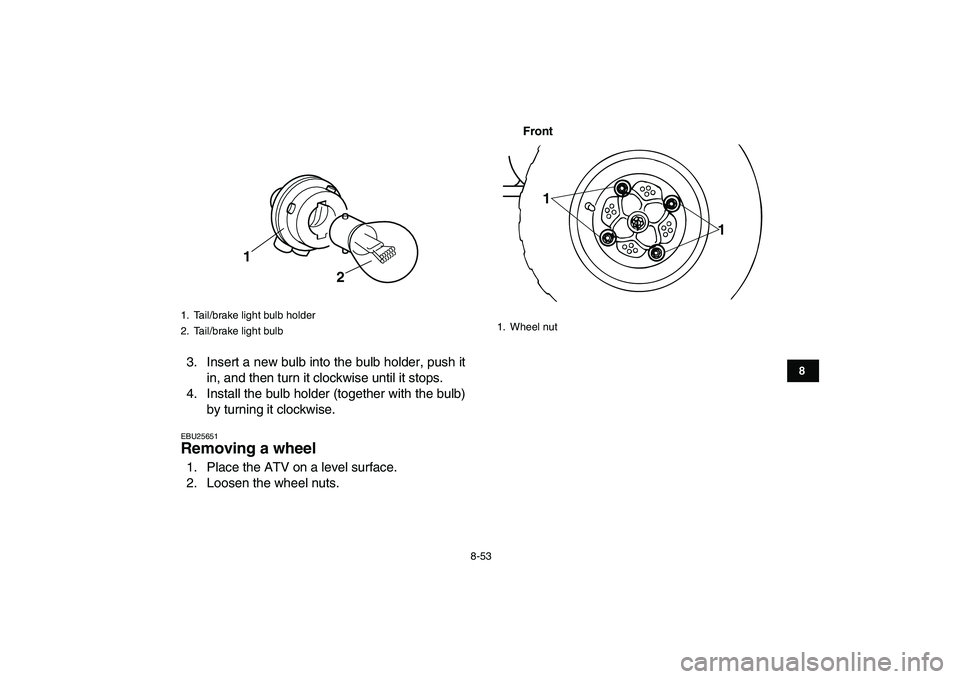
8-53
1
2
3
4
5
6
78
9
10
11
3. Insert a new bulb into the bulb holder, push it
in, and then turn it clockwise until it stops.
4. Install the bulb holder (together with the bulb)
by turning it clockwise.
EBU25651
Removing a wheel
1. Place the ATV on a level surface.
2. Loosen the wheel nuts.
Front
1. Tail/brake light bulb holder
2. Tail/brake light bulb
1
2
1. Wheel nut
1
1
Page 132 of 148
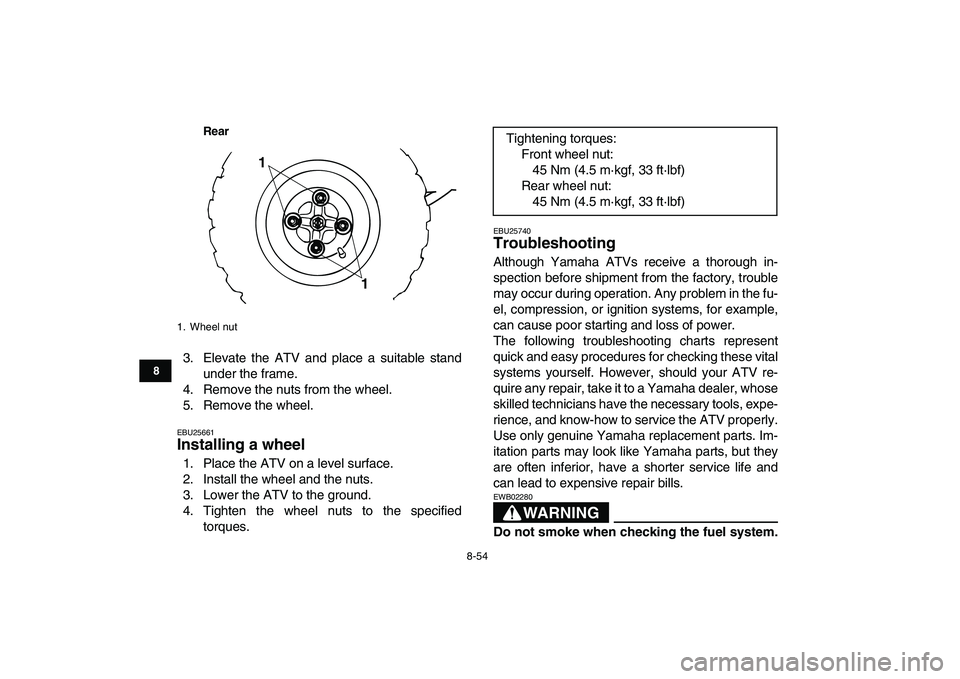
8-54
1
2
3
4
5
6
78
9
10
11
Rear
3. Elevate the ATV and place a suitable stand
under the frame.
4. Remove the nuts from the wheel.
5. Remove the wheel.
EBU25661
Installing a wheel
1. Place the ATV on a level surface.
2. Install the wheel and the nuts.
3. Lower the ATV to the ground.
4. Tighten the wheel nuts to the specified
torques.
EBU25740
Troubleshooting
Although Yamaha ATVs receive a thorough in-
spection before shipment from the factory, trouble
may occur during operation. Any problem in the fu-
el, compression, or ignition systems, for example,
can cause poor starting and loss of power.
The following troubleshooting charts represent
quick and easy procedures for checking these vital
systems yourself. However, should your ATV re-
quire any repair, take it to a Yamaha dealer, whose
skilled technicians have the necessary tools, expe-
rience, and know-how to service the ATV properly.
Use only genuine Yamaha replacement parts. Im-
itation parts may look like Yamaha parts, but they
are often inferior, have a shorter service life and
can lead to expensive repair bills.WARNING
EWB02280
Do not smoke when checking the fuel system.
1. Wheel nut
1
1
Tightening torques:
Front wheel nut:
45 Nm (4.5 m·kgf, 33 ft·lbf)
Rear wheel nut:
45 Nm (4.5 m·kgf, 33 ft·lbf)
Page 133 of 148
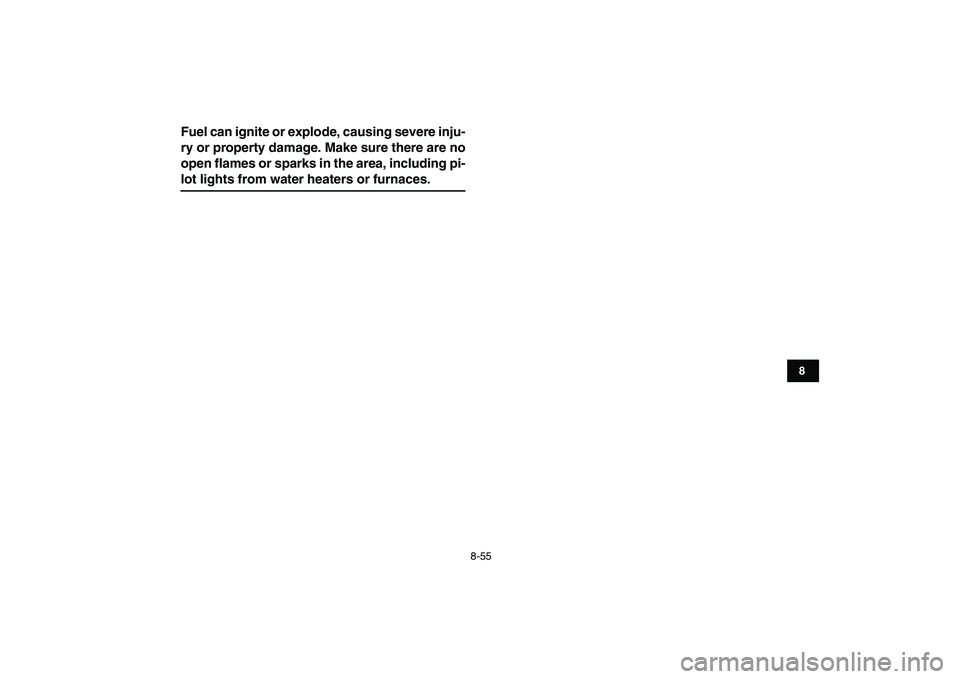
8-55
1
2
3
4
5
6
78
9
10
11
Fuel can ignite or explode, causing severe inju-
ry or property damage. Make sure there are no
open flames or sparks in the area, including pi-
lot lights from water heaters or furnaces.
Page 134 of 148
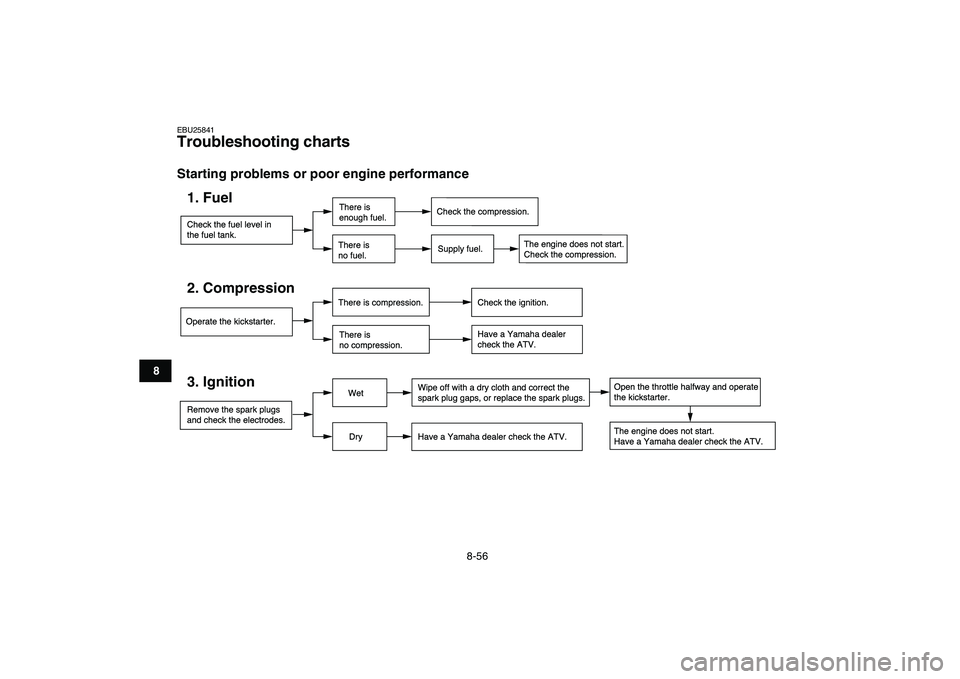
8-56
1
2
3
4
5
6
78
9
10
11
EBU25841
Troubleshooting charts
Starting problems or poor engine performance
Check the fuel level in
the fuel tank.1. Fuel
There is
enough fuel.
There is
no fuel.
Supply fuel.
Operate the kickstarter.2. Compression
There is compression.
There is
no compression.Check the ignition.
Have a Yamaha dealer
check the ATV.
Remove the spark plugs
and check the electrodes.3. Ignition
Wet
DryWipe off with a dry cloth and correct the
spark plug gaps, or replace the spark plugs.
Have a Yamaha dealer check the ATV.The engine does not start.
Have a Yamaha dealer check the ATV.
Open the throttle halfway and operate
the kickstarter.
Check the compression.
The engine does not start.
Check the compression.
Page 135 of 148
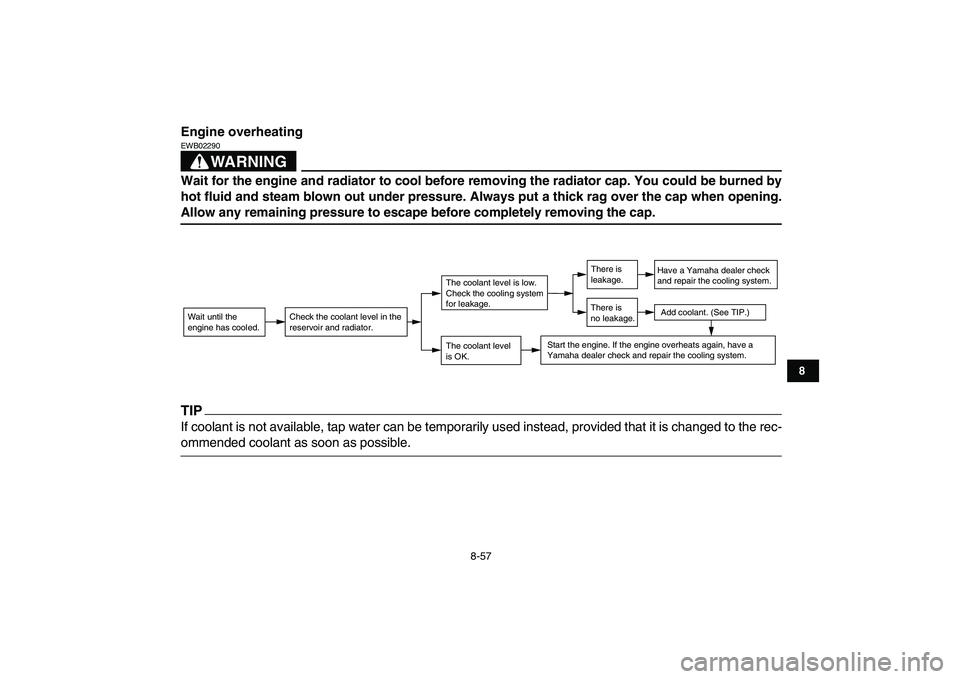
8-57
1
2
3
4
5
6
78
9
10
11
Engine overheating
WARNING
EWB02290
Wait for the engine and radiator to cool before removing the radiator cap. You could be burned by
hot fluid and steam blown out under pressure. Always put a thick rag over the cap when opening.
Allow any remaining pressure to escape before completely removing the cap.
TIP
If coolant is not available, tap water can be temporarily used instead, provided that it is changed to the rec-
ommended coolant as soon as possible.
Wait until the
engine has cooled.
Check the coolant level in the
reservoir and radiator.
The coolant level
is OK.The coolant level is low.
Check the cooling system
for leakage.
Have a Yamaha dealer check
and repair the cooling system.Add coolant. (See TIP.)
Start the engine. If the engine overheats again, have a
Yamaha dealer check and repair the cooling system.
There is
leakage.
There is
no leakage.
Page 136 of 148
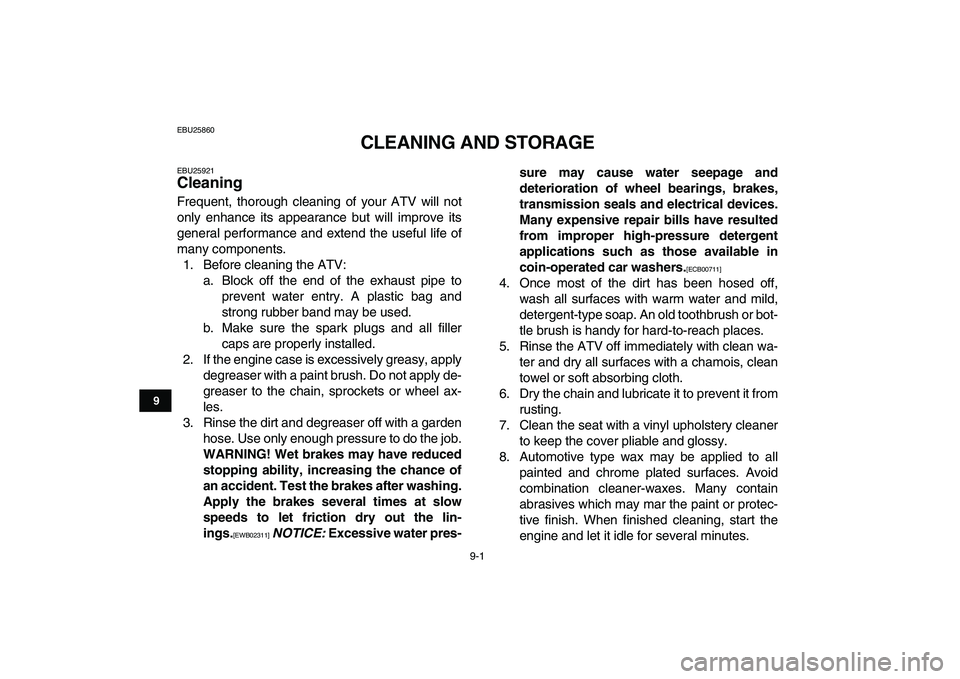
9-1
1
2
3
4
5
6
7
89
10
11
EBU25860
CLEANING AND STORAGE
EBU25921
Cleaning
Frequent, thorough cleaning of your ATV will not
only enhance its appearance but will improve its
general performance and extend the useful life of
many components.
1. Before cleaning the ATV:
a. Block off the end of the exhaust pipe to
prevent water entry. A plastic bag and
strong rubber band may be used.
b. Make sure the spark plugs and all filler
caps are properly installed.
2. If the engine case is excessively greasy, apply
degreaser with a paint brush. Do not apply de-
greaser to the chain, sprockets or wheel ax-
les.
3. Rinse the dirt and degreaser off with a garden
hose. Use only enough pressure to do the job.
WARNING! Wet brakes may have reduced
stopping ability, increasing the chance of
an accident. Test the brakes after washing.
Apply the brakes several times at slow
speeds to let friction dry out the lin-
ings.
[EWB02311]
NOTICE:
Excessive water pres-sure may cause water seepage and
deterioration of wheel bearings, brakes,
transmission seals and electrical devices.
Many expensive repair bills have resulted
from improper high-pressure detergent
applications such as those available in
coin-operated car washers.
[ECB00711]
4. Once most of the dirt has been hosed off,
wash all surfaces with warm water and mild,
detergent-type soap. An old toothbrush or bot-
tle brush is handy for hard-to-reach places.
5. Rinse the ATV off immediately with clean wa-
ter and dry all surfaces with a chamois, clean
towel or soft absorbing cloth.
6. Dry the chain and lubricate it to prevent it from
rusting.
7. Clean the seat with a vinyl upholstery cleaner
to keep the cover pliable and glossy.
8. Automotive type wax may be applied to all
painted and chrome plated surfaces. Avoid
combination cleaner-waxes. Many contain
abrasives which may mar the paint or protec-
tive finish. When finished cleaning, start the
engine and let it idle for several minutes.
Page 137 of 148
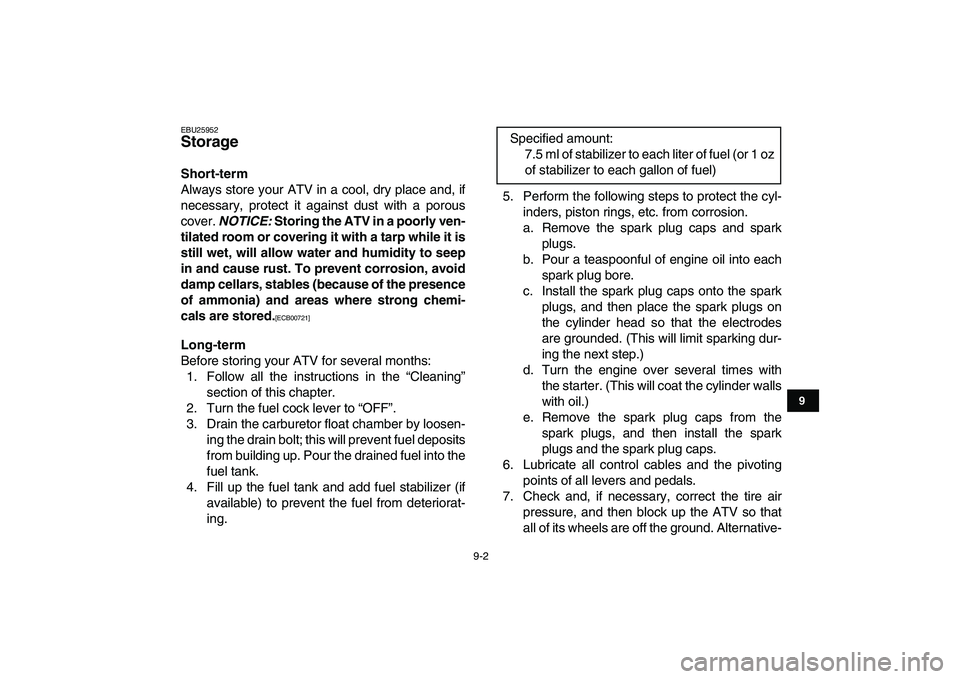
9-2
1
2
3
4
5
6
7
89
10
11
EBU25952
Storage
Short-term
Always store your ATV in a cool, dry place and, if
necessary, protect it against dust with a porous
cover.
NOTICE:
Storing the ATV in a poorly ven-
tilated room or covering it with a tarp while it is
still wet, will allow water and humidity to seep
in and cause rust. To prevent corrosion, avoid
damp cellars, stables (because of the presence
of ammonia) and areas where strong chemi-
cals are stored.
[ECB00721]
Long-term
Before storing your ATV for several months:
1. Follow all the instructions in the “Cleaning”
section of this chapter.
2. Turn the fuel cock lever to “OFF”.
3. Drain the carburetor float chamber by loosen-
ing the drain bolt; this will prevent fuel deposits
from building up. Pour the drained fuel into the
fuel tank.
4. Fill up the fuel tank and add fuel stabilizer (if
available) to prevent the fuel from deteriorat-
ing.5. Perform the following steps to protect the cyl-
inders, piston rings, etc. from corrosion.
a. Remove the spark plug caps and spark
plugs.
b. Pour a teaspoonful of engine oil into each
spark plug bore.
c. Install the spark plug caps onto the spark
plugs, and then place the spark plugs on
the cylinder head so that the electrodes
are grounded. (This will limit sparking dur-
ing the next step.)
d. Turn the engine over several times with
the starter. (This will coat the cylinder walls
with oil.)
e. Remove the spark plug caps from the
spark plugs, and then install the spark
plugs and the spark plug caps.
6. Lubricate all control cables and the pivoting
points of all levers and pedals.
7. Check and, if necessary, correct the tire air
pressure, and then block up the ATV so that
all of its wheels are off the ground. Alternative- Specified amount:
7.5 ml of stabilizer to each liter of fuel (or 1 oz
of stabilizer to each gallon of fuel)
Page 138 of 148
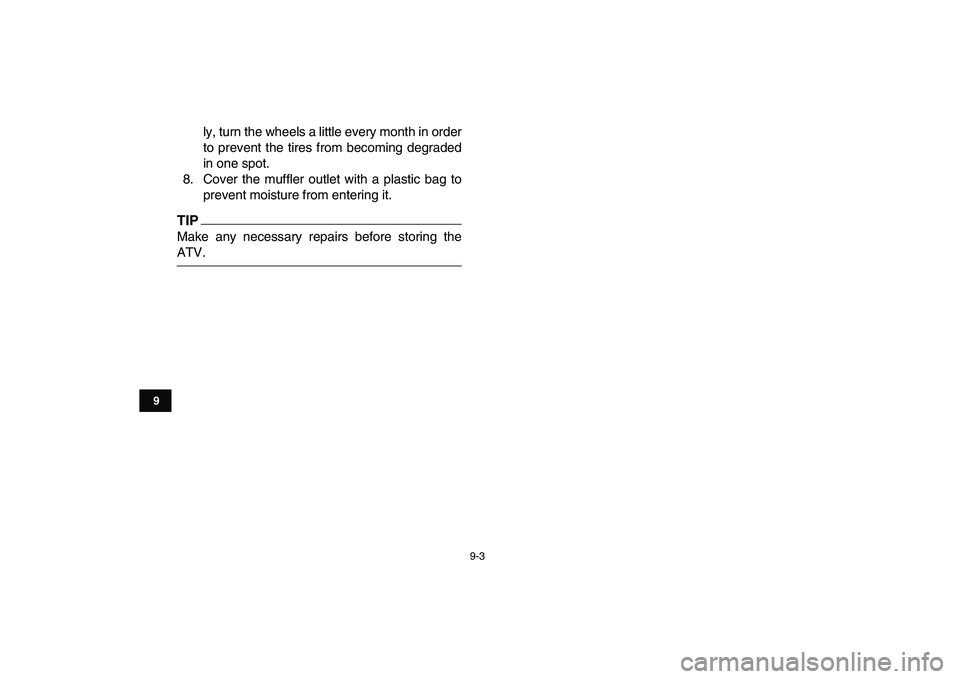
9-3
1
2
3
4
5
6
7
89
10
11
ly, turn the wheels a little every month in order
to prevent the tires from becoming degraded
in one spot.
8. Cover the muffler outlet with a plastic bag to
prevent moisture from entering it.
TIP
Make any necessary repairs before storing the
ATV.
Page 139 of 148
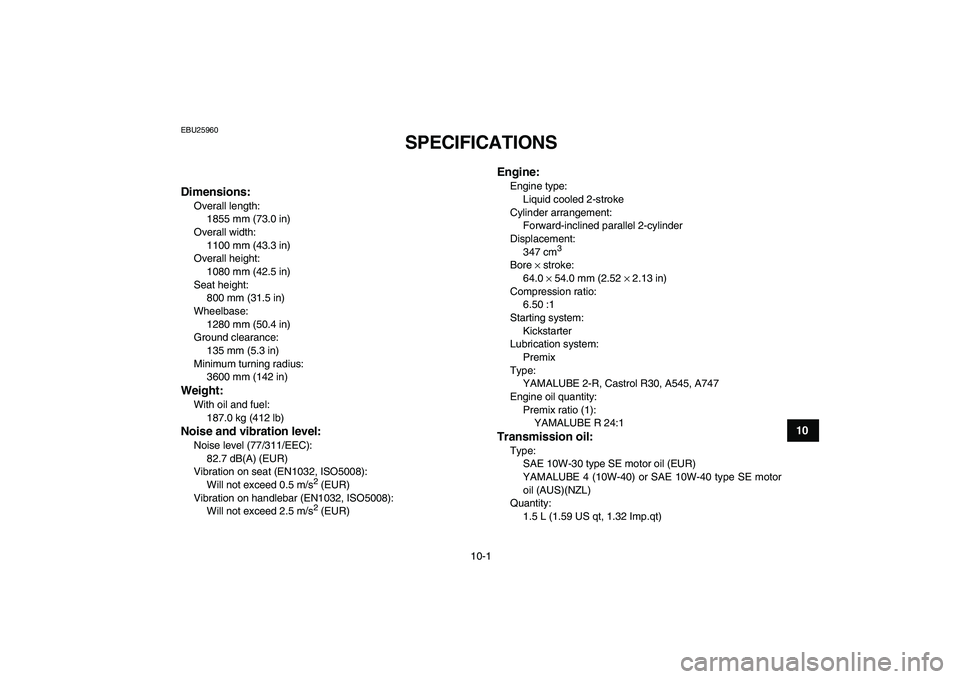
10-1
1
2
3
4
5
6
7
8
910
11
EBU25960
SPECIFICATIONS
EBU2597G
Dimensions:
Overall length:
1855 mm (73.0 in)
Overall width:
1100 mm (43.3 in)
Overall height:
1080 mm (42.5 in)
Seat height:
800 mm (31.5 in)
Wheelbase:
1280 mm (50.4 in)
Ground clearance:
135 mm (5.3 in)
Minimum turning radius:
3600 mm (142 in)
Weight:
With oil and fuel:
187.0 kg (412 lb)
Noise and vibration level:
Noise level (77/311/EEC):
82.7 dB(A) (EUR)
Vibration on seat (EN1032, ISO5008):
Will not exceed 0.5 m/s
2
(EUR)
Vibration on handlebar (EN1032, ISO5008):
Will not exceed 2.5 m/s
2
(EUR)
Engine:
Engine type:
Liquid cooled 2-stroke
Cylinder arrangement:
Forward-inclined parallel 2-cylinder
Displacement:
347 cm
3
Bore
×
stroke:
64.0
×
54.0 mm (2.52
×
2.13 in)
Compression ratio:
6.50 :1
Starting system:
Kickstarter
Lubrication system:
Premix
Type:
YAMALUBE 2-R, Castrol R30, A545, A747
Engine oil quantity:
Premix ratio (1):
YAMALUBE R 24:1
Transmission oil:
Type:
SAE 10W-30 type SE motor oil (EUR)
YAMALUBE 4 (10W-40) or SAE 10W-40 type SE motor
oil (AUS)(NZL)
Quantity:
1.5 L (1.59 US qt, 1.32 Imp.qt)
Page 140 of 148
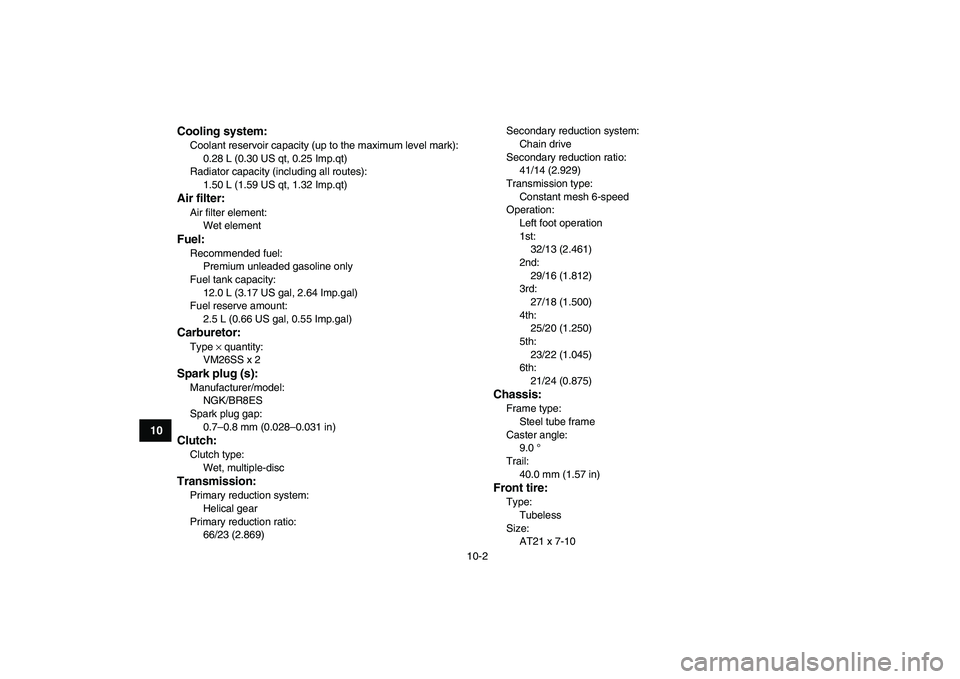
10-2
1
2
3
4
5
6
7
8
910
11
Cooling system:
Coolant reservoir capacity (up to the maximum level mark):
0.28 L (0.30 US qt, 0.25 Imp.qt)
Radiator capacity (including all routes):
1.50 L (1.59 US qt, 1.32 Imp.qt)
Air filter:
Air filter element:
Wet element
Fuel:
Recommended fuel:
Premium unleaded gasoline only
Fuel tank capacity:
12.0 L (3.17 US gal, 2.64 Imp.gal)
Fuel reserve amount:
2.5 L (0.66 US gal, 0.55 Imp.gal)
Carburetor:
Type
×
quantity:
VM26SS x 2
Spark plug (s):
Manufacturer/model:
NGK/BR8ES
Spark plug gap:
0.7–0.8 mm (0.028–0.031 in)
Clutch:
Clutch type:
Wet, multiple-disc
Transmission:
Primary reduction system:
Helical gear
Primary reduction ratio:
66/23 (2.869)Secondary reduction system:
Chain drive
Secondary reduction ratio:
41/14 (2.929)
Transmission type:
Constant mesh 6-speed
Operation:
Left foot operation
1st:
32/13 (2.461)
2nd:
29/16 (1.812)
3rd:
27/18 (1.500)
4th:
25/20 (1.250)
5th:
23/22 (1.045)
6th:
21/24 (0.875)
Chassis:
Frame type:
Steel tube frame
Caster angle:
9.0 °
Trail:
40.0 mm (1.57 in)
Front tire:
Type:
Tubeless
Size:
AT21 x 7-10